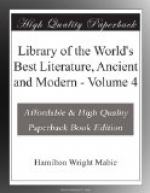Fletcher was born in Rye, Sussex, the son of a minister who later became Bishop of London. Giles Fletcher the Younger, and Phineas Fletcher, both well-known poets in their day, were his cousins. His early life is as little known as that of Beaumont, and indeed as the lives of most of the other Elizabethan dramatists. He was a pensioner at Benet College, now Corpus Christi, Cambridge, in 1591, and in 1593 he was “Bible-clerk” there. Then we hear nothing of him until ‘The Woman Hater’ was brought out in 1607. The play has been ascribed to Beaumont alone, to Fletcher alone, and to the two jointly. Whoever may be the author, it is the firstling of his dramatic muse, and worth merely a passing mention. How or when their literary friendship began is not known; but since both were friends of Jonson, both prefixing commendatory verses to the great realist’s play of ‘The Fox,’ it is fair to assume that through him they were brought together, and that both belonged to that brilliant circle of wits, poets, and dramatists who made famous the gatherings at the Mermaid Inn.
They lived in the closest intimacy on the Bankside, near the Globe Theatre in Southwark, sharing everything in common, even the bed, and some say their clothing,—which is likely enough, as it can be paralleled without going back three centuries. It is certain that the more affluent circumstances of Beaumont tided his less fortunate friend over many a difficulty; and the astonishing dramatic productivity of Fletcher’s later period was probably due to Beaumont’s untimely death, making it necessary for Fletcher to rely on his pen for support.
In 1613 Beaumont’s marriage to a Kentish heiress put an end to the communistic bachelor establishment. He died March 6th, 1616, not quite six weeks before Shakespeare, and was buried in Westminster Abbey. Fletcher survived him nine years, dying of the plague in 1625. He was buried, not by the side of the poet with whose name his own is forever linked, but at St. Saviour’s, Southwark.
“A student of physiognomy,” says Swinburne, “will not fail to mark the points of likeness and of difference between the faces of the two friends; both models of noble manhood.... Beaumont the statelier and serener of the two, with clear, thoughtful eyes, full arched brows, and strong aquiline nose, with a little cleft at the tip; a grave and beautiful mouth, with full and finely curved lips; the form of face a very pure oval, and the imperial head, with its ‘fair large front’ and clustering hair, set firm and carried high with an aspect of quiet command and knightly observation. Fletcher with more keen and fervid face, sharper in outline every way, with an air of bright ardor and glad, fiery impatience; sanguine and nervous, suiting the complexion and color of hair; the expression of the eager eyes and lips almost rivaling that of a noble hound in act to break the leash it strains at;—two heads as lordly of feature and as expressive of aspect as any gallery of great men can show.”




